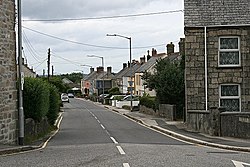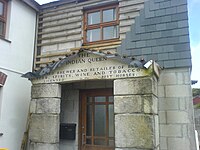Indian Queens
| Indian Queens | |
| Cornwall | |
|---|---|
 St Francis Road, Indian Queens | |
| Location | |
| Grid reference: | SW917588 |
| Location: | 50°23’33"N, 4°55’54"W |
| Data | |
| Population: | First argument to "number_format" must be a number. |
| Post town: | St Columb |
| Postcode: | TR9 |
| Dialling code: | 01726 |
| Local Government | |
| Council: | Cornwall |
| Parliamentary constituency: |
North Cornwall |
Indian Queens is a village in Cornwall. The village is situated west of Goss Moor and north of Fraddon approximately ten miles west-southwest of Bodmin.
The village used to be a familiar place for tourists as the A30 trunk road to Penzance ran through the village, until the construction of a bypass in the 1990s.
Who was the Indian Queen?
The village takes its name from a public house or coaching inn which once stood here. There are however several stories which try to explain who the Indian Queen was. The name cannot be traced earlier than the 19th century.
The inn was built on a plot of land known as White Splat in the late 18th century. The Indian Queen Inn stood beside the road leading from Goss Moor to Fraddon, just below the top of the hill. The pub had a small porch and displayed as a sign the portrait of an Indian queen. An inscription on the porch told the story of a Portuguese princess who landed at Falmouth in the days of the packet ships, and slept one night at this inn on her way to London. Her swarthy appearance gave onlookers the impression that she was a Red Indian.


It has also been suggested that the royal lady was Pocahontas (1595–1617), an American Indian who was the younger daughter of Powhatan, chief of the Indian tribes who lived along the Virginia coast. There is very little evidence to support this story; nevertheless, it is still commonly given as the origin of the name. Pocahontas's name has been given to a modern street in Indian Queens known as Pocahontas Crescent.
Up to April 1780, the inn had the name "The Queen's Head". At some time thereafter, and definitely by 1787, it had become "The Indian Queen". It seems that the name became "The Indian Queens" around the end of the 19th century and the signboard displayed an American Indian on one side and Victoria as Queen of India on the other.
The pub was demolished in the 1960s and its old signboard resides in the Truro Museum. In 2009 the old stone lintel from the pub re-appeared on a house in Indian Queens not far from the site of the original pub. It bears the inscription:
"THE INDIAN QUEEN
LICENSED BREWER AND RETAILER OF BEER, CYDER, WINE, AND TOBACCO.
LICENSED to the POST HORSES"
Outside links
| ("Wikimedia Commons" has material about Indian Queens) |
References
- Noall, Cyril (1966) A History of Cornish Mail- and Stage-Coaches. Truro: D. Bradford Barton ISBN 0-85153-056-7
- Douch, H. L. (1966) Old Cornish Inns and their place in the social history of the County. Truro: D. Bradford Barton
- Vigurs, C. C. (article in) Devon and Cornwall Notes and Queries; No. 416
